Many SMBs hesitate to embrace inclusive marketing for fear of getting it wrong.
However, meeting accessibility standards and reaching a wider audience is often simpler than it seems.
In this post, you’ll learn five steps to create an inclusive marketing strategy that gives you a competitive edge, builds brand loyalty and drives sales.
Key takeaways for inclusive marketing
Inclusive marketing means creating campaigns that reflect a range of identities, abilities and experiences.
While inclusive marketing can lead to stronger engagement and loyalty, it must become an ongoing process to feel authentic and resonate.
Success stems from speaking to your customers, auditing your current marketing, ensuring accessible design and measuring group engagement.
Pipedrive helps segment audiences, personalize outreach and track which inclusive efforts lead to purchases – try it free for 14 days.
What is inclusive marketing?
Inclusive marketing means creating campaigns that represent, respect and resonate with diverse audiences.
It ensures people of different backgrounds, abilities and identities feel genuinely seen in your brand’s messaging.
For example, Adobe’s When I See Black campaign highlighted the work of twelve Black artists.
The software giant spotlighted diverse creators during Black History Month, allowing them to showcase how they see themselves.
As a DEI (diversity, equity and inclusion) initiative, inclusive marketing influences how you communicate with customers.
Your brand then becomes accessible, authentic and relevant to all.
These practices help businesses build customer trust and reach a wider audience without increasing spend. It usually just takes time and a series of small, thoughtful changes.
Think of a small HR and employee management software company that refreshes its visuals to feature more types of business owners, such as:
Women-led startup companies
Older entrepreneurs
LGBTQ+ founders
Teams working remotely across different cultures
This shift helps them connect with a broader audience who now see themselves reflected in the product story.
Here are several ways inclusive marketing can show up:
Inclusive marketing tactic | What this looks like |
Representation in visuals and content | Highlighting different ethnicities, gender identities, ages, abilities, sexual orientations and body types. |
Inclusive language | Avoiding jargon or stereotypes and using gender-neutral terms where appropriate. |
Accessible design | Adding alt text, captions and high-contrast design for people with low vision or hearing. |
Cultural sensitivity | Acknowledging different traditions while avoiding tokenism (i.e., only making a symbolic effort). |
Product inclusivity | Offering different sizes, formats or use cases to include everyone. |
Alternative channels | Showing up where overlooked audiences spend time (e.g., community radio, local newsletters or language-specific forums). |
Diverse representation is crucial for more people to relate to your brand story and visuals and eventually buy.
Small and medium businesses (SMBs) that build stronger connections with all types of customers stand out from competitors that stick to “one-size-fits-all” messaging.
What are the data-backed benefits of inclusive marketing?
Brands that consistently embrace diversity and inclusion in their messaging see boosts in engagement, customer loyalty and purchasing behavior.
Here are three key benefits, each supported by solid data.
Drives purchase behavior
Inclusive campaigns persuade people to purchase. When people or companies see themselves reflected in your story, they’re more likely to take the next step towards a sale.
According to Numerator research, almost half of American consumers (47%) will likely buy from brands that highlight diversity.
Other DISQO findings back this up. Around 60% of customers say inclusive ads influence their buying decisions. Within LGBTQ+ groups, that number is even higher (77%).
For small companies, this translates into real sales opportunities.
Example: An IT consulting firm begins offering webinars with live captions and multilingual support. Attendance at virtual events doubles and more sales prospects book follow-up calls.
Increases brand loyalty and trust
Inclusive marketing builds deeper, long-term trust as consumers often stick with brands they feel genuinely represent them.
Unstereotype Alliance research indicates that brands that use inclusivity in ads reduce the chance of abandonment after trial by 23% and enjoy 15% higher loyalty overall.
For small business-to-business (B2B) sales companies, that can be the difference between one-off sales and lasting customer relationships.
Example: A manufacturing business acknowledges regional holidays and cultural touchpoints in emails. Repeat orders grow steadily as customers feel the supplier truly understands and values them.
Gives you a competitive advantage
Accessibility isn’t just an ethical box to check. It’s a way to win over customers whom competitors often underrepresent.
According to the World Health Organization, around 16% of the global population lives with some form of disability.
Yet many companies still neglect people with disabilities in their sales and marketing materials.
Brands that prioritize inclusion stand out and capture market share. They even seem more meaningful (8.3%) and differentiated (12.1%) by respondents in the same Unstereotype Alliance study.
Example: A small logistics firm sends docs in HTML pages and tagged PDFs for screen readers. Distributors praise it for being considerate and easier to work with than competitors.
How to create an inclusive marketing strategy as an SMB
By planning your inclusive marketing strategy step by step, you’ll avoid guesswork and create compelling campaigns that feel more authentic.
SMBs are often closer to their customers and communities. You’re perfectly positioned to produce content that reflects the people you serve.
Here are five tips to get started.
1. Talk directly to your audience and get to know them
By understanding your customers across different identities, needs and experiences, you’ll create campaigns that resonate more deeply and avoid missing entire market segments.
When doing audience research, many SMBs build ideal customer profiles (ICPs) and buyer personas that cover job titles and budgets.
Here’s what an ICP looks like:
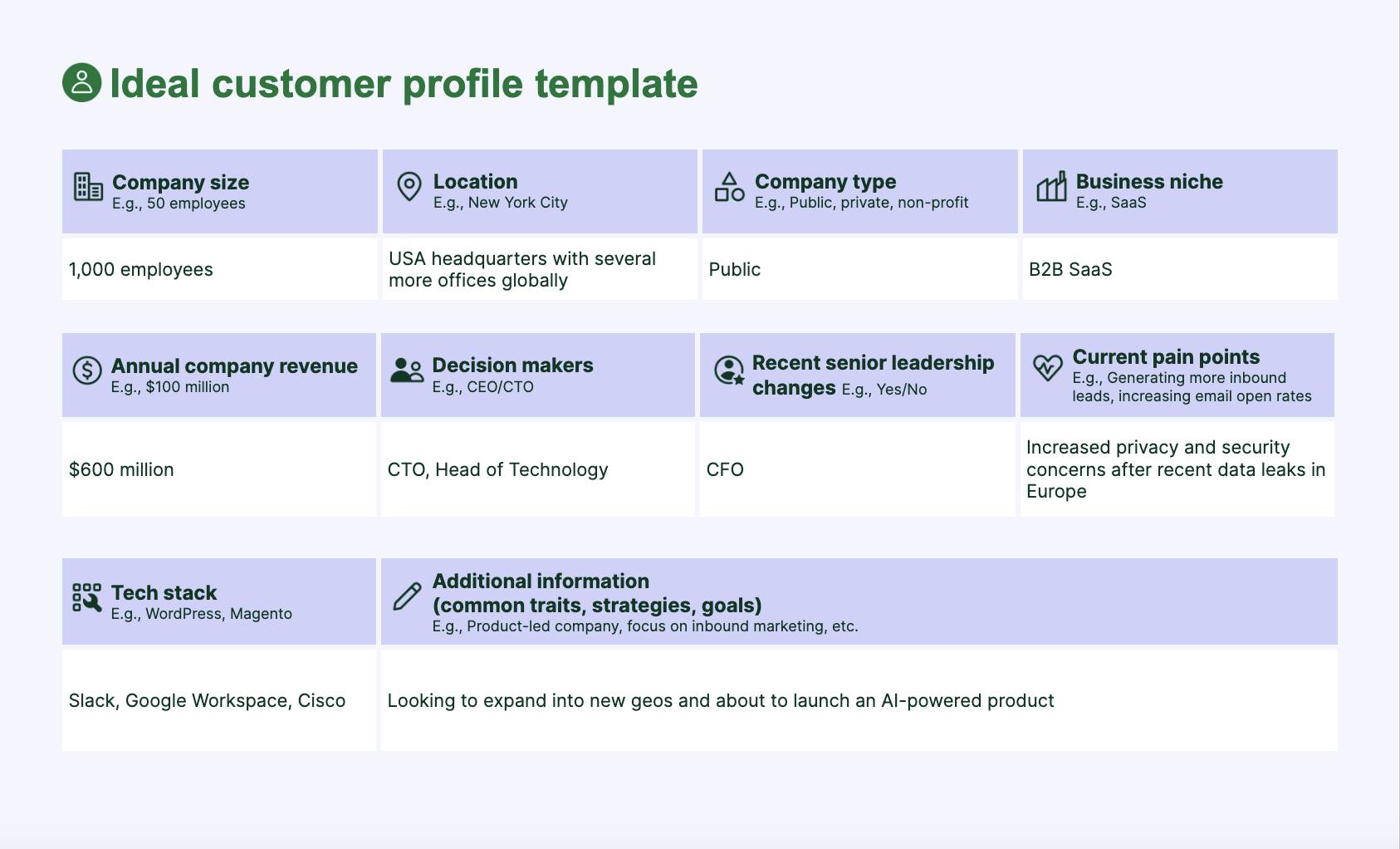
.
Download your ideal customer profile template
While useful, inclusive marketing requires going further. You need to find out if you’re:
Considering customers who speak different languages
Accounting for accessibility needs like screen reader compatibility
Reflecting generational or cultural differences in how people prefer to engage
Primary research makes the difference here. Talking directly to your customers surfaces fresh, first-hand insights about barriers you may not see.
For example, a small payroll services firm may assume its clients are tech-savvy accountants.
After speaking to its customer base, it realizes many are small business owners with limited financial training and English as a second language.
By adding multilingual support and simplifying instructions, the firm makes its services more appealing to a broader set of clients and sees an uptick in satisfaction scores.
Here’s how to get to know your diverse audience:
Run short interviews and focus groups with customers from different backgrounds to spot needs you might miss in a one-size-fits-all persona
Layer in surveys that ask about inclusion preferences (e.g., “Do you prefer written, video or multilingual resources?”) instead of only business goals
Observe real behavior across segments using analytics tools like Hotjar or Fullstory (e.g., check if new users with accessibility needs complete onboarding at the same rate as others)
Build an “audience inclusion map” that highlights underserved groups of people (by factors like language, ability, socio-economic status or age) to see representation levels
When you know who you’re marketing to, inclusivity stops being a checkbox exercise and becomes a natural reflection of who you serve.
2. Audit your current marketing to spot improvement areas
A marketing audit helps you spot gaps, biases or barriers that may exclude audiences, so you can fix them and build stronger connections.
Many SMBs unintentionally lean on stock imagery or jargon-heavy copy because it’s the simplest option.
For example, of these two free stock images, one includes a far more diverse range of people:

With an audit, you’ll pinpoint these instances and update your marketing.
Say an accounting platform previously wished users “Happy holidays”, but only showed Christmas imagery.
After expanding to include content around Ramadan, Diwali and Lunar New Year, its marketing is now more welcoming and relevant to others.
Here’s how to audit your content effectively:
Review your website and sales materials. Do your visuals reflect a range of subjects? Do they all look the same?
Check accessibility basics. Are forms easy to navigate with a keyboard? Do images have alt text? Is the text readable against background colors?
Look at language. Are you using overly technical terms? Gendered pronouns? Cultural references that visitors may not broadly relate to?
Assess your channels. Does your email list or social media ad targeting skew heavily toward one segment? Are you leaving out underrepresented groups?
Once you’ve been through everything as a team, ask a diverse group of colleagues, partners or even customers to give feedback on whether you feel like an inclusive brand.
Turn auditing into a regular process to ensure your digital marketing efforts continue to reflect a wide array of buyers.
Download Your Sales and Marketing Strategy Guide
3. Rely on the key principles of inclusive marketing
Following the guiding principles of inclusive marketing helps every audience feel seen and valued in your campaigns.
Instead of appearing performative, your marketing will feel authentic and resonate more.
Too often, brands make one-off gestures (like a single campaign for Pride Month) instead of embedding inclusivity into everything they do.
However, 88% of LGBTQ+ consumers and 50% of the general public feel brands should support the community all year round.
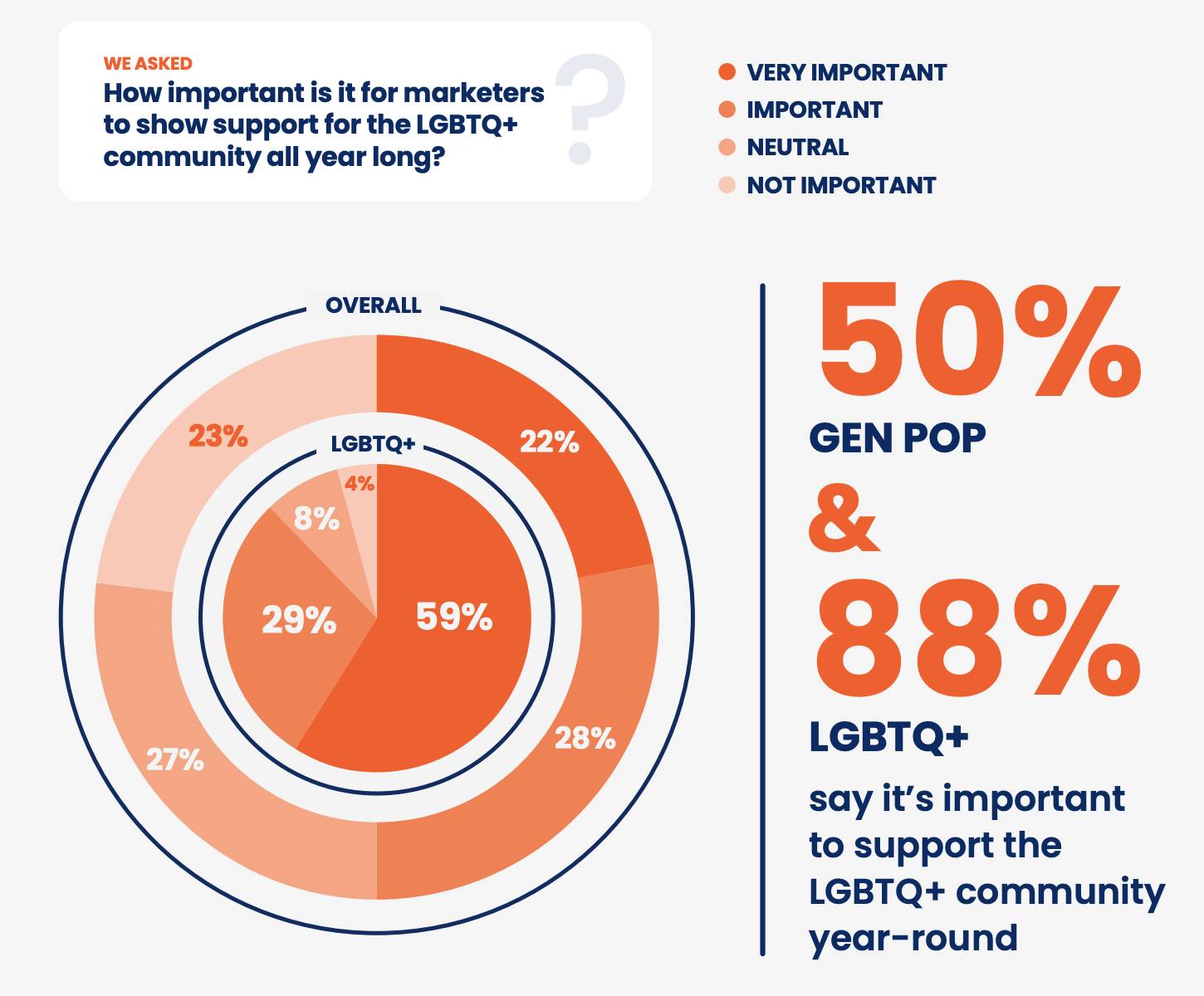
For example, a cybersecurity firm might promote its platform as “built for every business”.
However, only integrating with US payment providers excludes international SMBs who would be great customers.
Imagine instead that the same firm builds integrations with regional providers and spotlights those companies in campaigns. The product becomes more inclusive while its marketing content reflects that real progress.
Here are some of the core principles of diverse marketing to bear in mind as you create:
Inclusive marketing principle | What it looks like in practice |
Authenticity | Speak honestly and back it up with actions, not token gestures. |
Representation | Share diverse voices, stories and visuals that reflect and appreciate all your customers. |
Accessibility | Design so everyone can engage with your content (i.e., add captions, alt text and clear language). |
Relevance | Respect cultural contexts, avoid stereotypes and adapt messaging for your audience. |
Intersectionality | Remember that people hold overlapping identities (e.g., race, gender, ability). |
Collaboration | Involve the communities you want to represent in your marketing. |
Consistency | Weave inclusivity across all campaigns, not just one-off moments. |
Inclusivity becomes a competitive advantage when you ground your content in these principles.
Instead of chasing marketing trends, your brand will build trust, loyalty and long-term relationships with the people you serve.
4. Design with accessibility in mind
Accessible design ensures that your entire audience can understand and engage with your website, app and content – so they’re more likely to buy.
However, it’s also a legal requirement under the Americans with Disabilities Act (ADA).
The US Department of Justice is also increasingly requiring online businesses to adhere to the international Web Content Accessibility Guidelines (WCAG).
For example, high color contrast ensures you can clearly read text and visuals against their backgrounds:
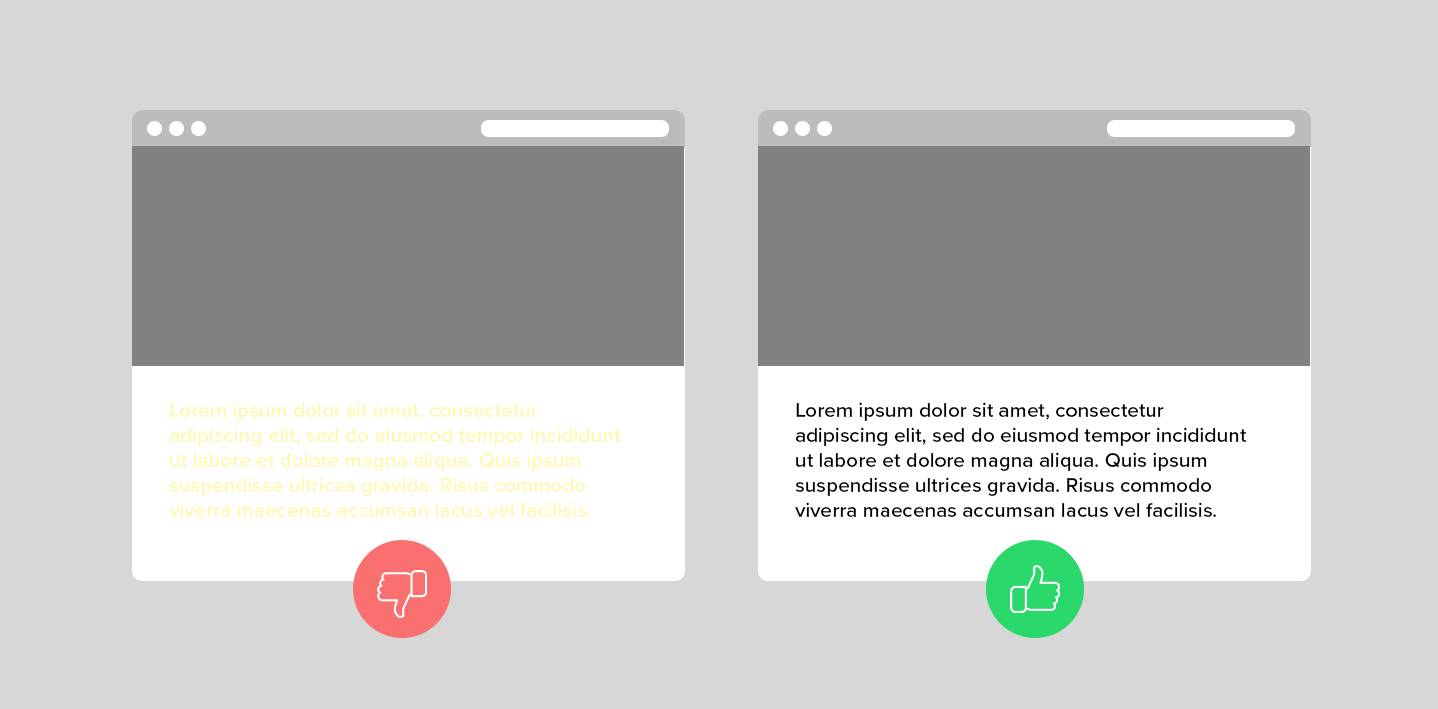
This ADA and WCAG guideline makes visual cues easier to find for people with low vision or color blindness.
Say you roll out a clean, fast-loading site where:
Users can navigate the whole thing with a keyboard
Videos include transcripts
Images have descriptive alt text
Suddenly, your marketing is welcoming, professional and usable by all types of buyers.
By considering those with visual, hearing, cognitive or mobility differences, you can stay compliant and expand your products and services to a larger audience.
Here’s how to build accessibility into your marketing:
Check color contrast and font size so text is easy to read for those with low vision
Add alt text to images and meaningful labels to buttons so screen readers can describe them clearly
Provide multiple content formats (e.g., videos with captions, audio versions of blogs and plain-text PDFs)
Keep navigation simple with clear headings and a logical flow
You can check your website’s accessibility for free using tools like Accessibility Checker:
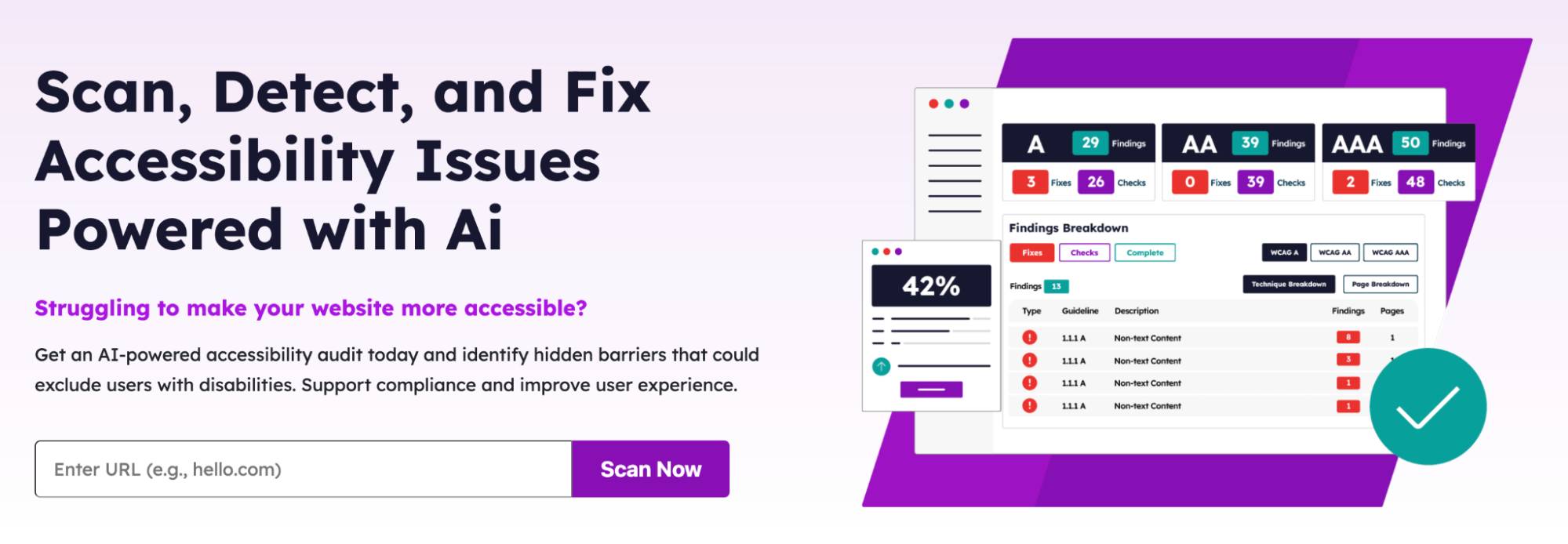
By referring to WCAG and ADA standards, the tool pinpoints compliance risks and suggests tips to avoid legal penalties.
5. Test, learn from and improve your inclusive campaigns
To assess and improve your inclusive marketing efforts, you need to measure results and gather feedback from the people you’re trying to reach.
Many SMBs publish campaigns and only track metrics like customer conversion or engagement rates.
Instead, you need to get more granular. Ask, “Who did this resonate with?” or “Who did it leave out?”
For instance, you may launch an email campaign and see strong engagement from US buyers:
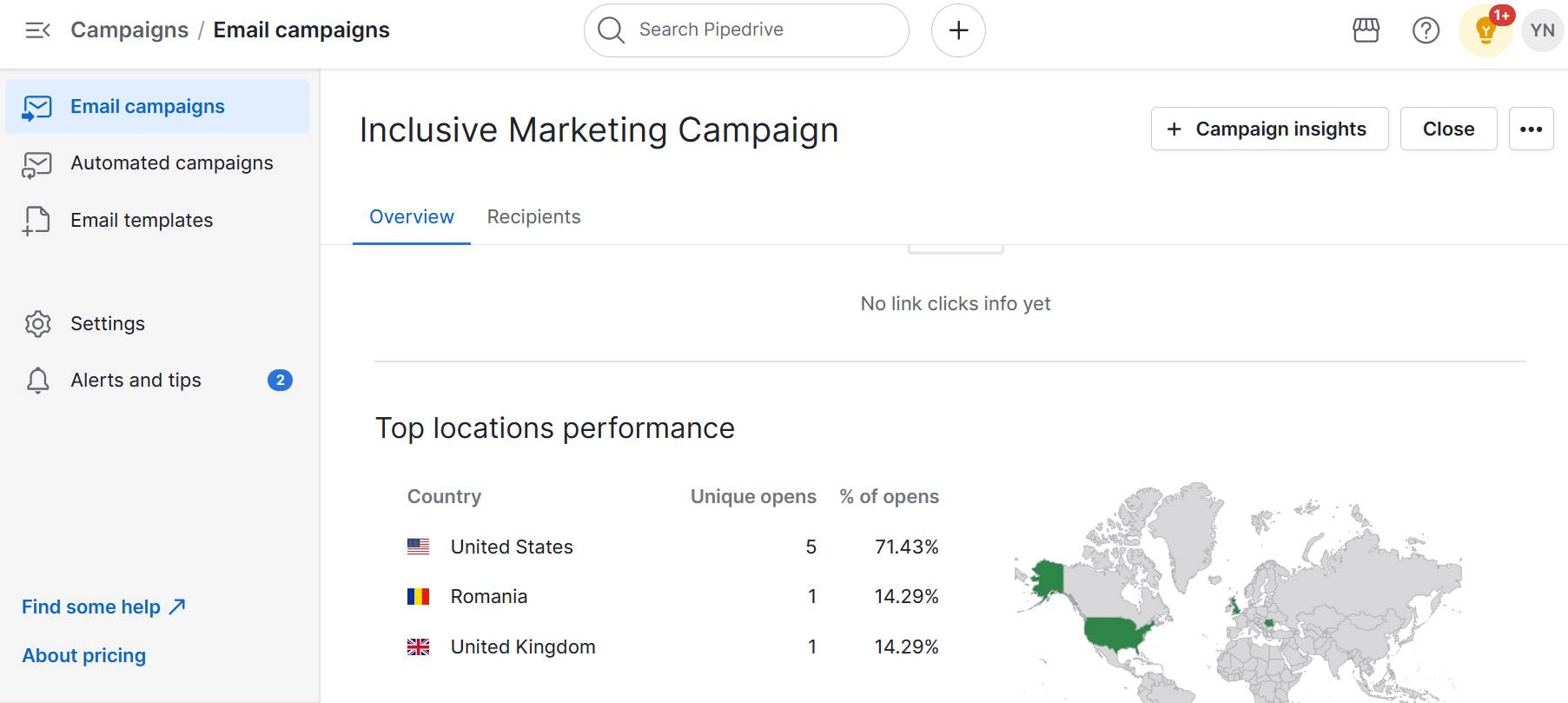
You may not realize that you’re unintentionally excluding overseas customers with imagery and messaging that feels “too American”.
Say you then start:
Testing messaging across regions
Adding customer interviews with global users
Reviewing analytics through the lens of inclusivity
You’ll quickly uncover these instances, adjust your campaigns and grow adoption in markets you’ve overlooked.
Here’s how to test and improve your new marketing efforts:
Measure engagement by segment and break down results by location, language or target audience group to see who’s engaging and who’s not
Run A/B tests that include inclusive variations (e.g., different imagery, formats or languages)
Regularly ask for and record direct feedback from diverse customers or community partners about whether your marketing feels relatable
Document and act on learnings so inclusivity isn’t a one-off but part of continuous improvement
Inclusive marketing must be iterative to be successful.
The more you test and listen, the better you’ll get at creating campaigns that truly connect with everyone you serve.
Pipedrive in action: Marketing agency CreativeRace wasn’t sure where its leads were coming from. By using Pipedrive’s centralized contact database and reporting capabilities, it increased client acquisition by 600%.
B2B examples of inclusive marketing campaigns to inspire you
Plenty of B2B marketing teams are proving that inclusivity can drive engagement and loyalty in professional settings.
For instance, HR tech startup Equitable HR Guild launched a guide during Pride Month on how to include LGBTQIA+ employees throughout the employee lifecycle:
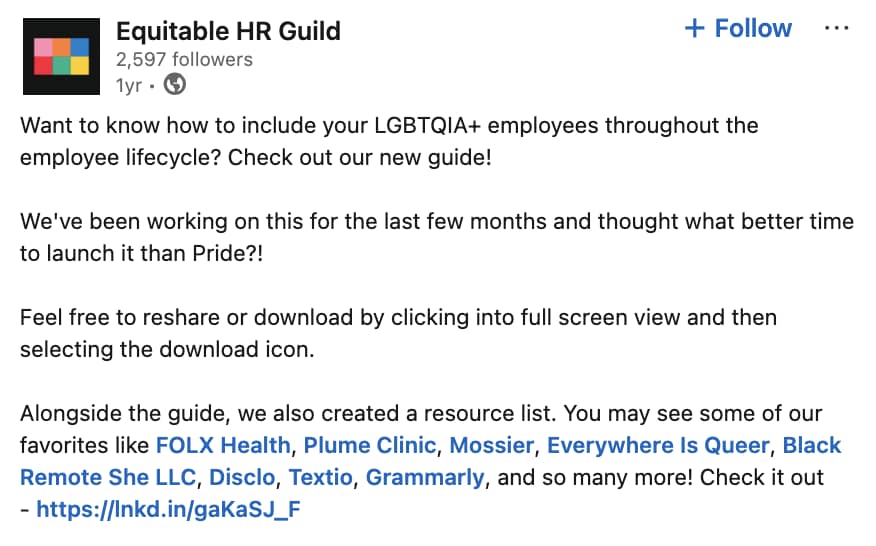
Instead of rainbow logos or a one-off celebration, the resource tied directly to the company’s brand values of equity and inclusion.
As it reflected the product’s core mission, the marketing team’s campaign came across as authentic and long-term, not just seasonal.
Here are five more inclusive marketing examples from larger B2B companies and what SMBs can still learn from them:
B2B company | Inclusive marketing example |
Microsoft | Launched campaigns showcasing disabled entrepreneurs using Microsoft tools. Takeaway for SMBs: Create case studies or blog posts spotlighting customers with different abilities to demonstrate your brand’s commitment to accessibility. |
Built LinkedIn Learning courses designed for diverse professionals, including accessibility-focused training. Takeaway for SMBs: Even a short guide or webinar series tailored for overlooked groups shows inclusivity. | |
IBM | Uses long-running initiatives to highlight accessibility in tech, featuring neurodiverse and disabled professionals. Takeaway for SMBs: Weave inclusivity into your ongoing messaging (not just one campaign) to build lasting credibility. |
Slack | Shared marketing and customer stories that highlighted remote work accessibility for global, cross-cultural teams. Takeaway for SMBs: If you serve international or distributed clients, reflect their realities in your marketing stories to show they belong. |
Canva | Created an inclusive visual library of photos and templates that showcased different races, body types and abilities. Takeaway for SMBs: Audit your visuals to ensure your stock photos, graphics or testimonials aren’t one-dimensional. |
While these are big-name brands, the lesson for small businesses is clear: inclusivity doesn’t require a Fortune 500 budget.
Since audiences don’t already have fixed opinions of your brand, SMBs can move faster, experiment more creatively and build trust quickly.
When creating your strategy, consider who and what is important to your brand and use the insights to chart your own path.
How Pipedrive enhances your inclusive marketing strategy
Pipedrive’s customer relationship management (CRM) tools allow SMBs to segment audiences, tailor communication and track what truly resonates in inclusive campaigns.
Instead of an afterthought, you can build inclusivity into the foundation of your marketing to understand, reach and support diverse audiences.
Here’s how to do it.
Use labels and filters to segment your audience
Start by using labels to group your audience by meaningful factors like language, location or industry.
Click “Add label” to create your own:
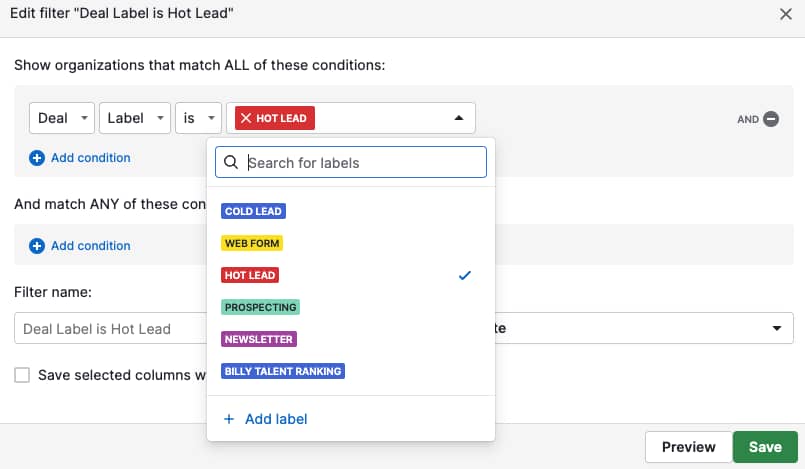
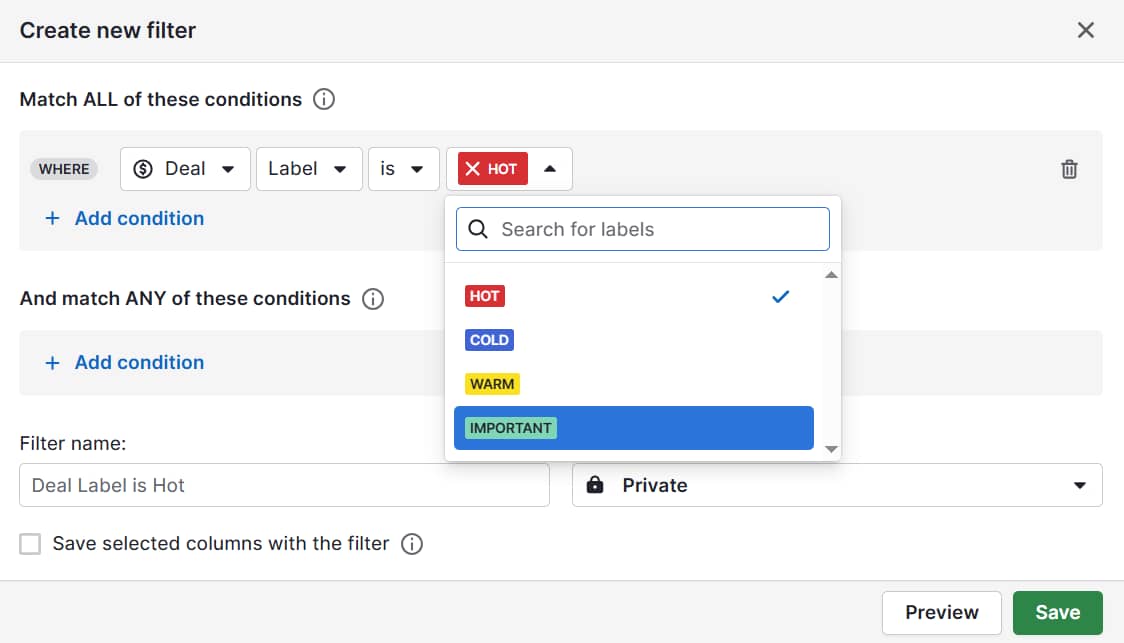
This segmentation prevents you from blasting the same message to everyone and sending communications that feel relevant and respectful.
Add custom fields to capture personalization details
Through custom fields and tags, you can respectfully capture details such as language preferences, communication styles and accessibility adaptations to tailor your outreach better.
Here’s how to set up custom fields in Pipedrive:
Instead of forcing people into a one-size-fits-all funnel, you’ll adapt your marketing to unique needs.
Use workflow automation to take pressure off your team
Set up workflow automations to schedule activities that make inclusive customer experiences feel effortless.
For instance, if someone indicates they prefer Spanish-language resources, you can automatically send translated content to increase engagement.
Here’s where workflow automation lives in Pipedrive:
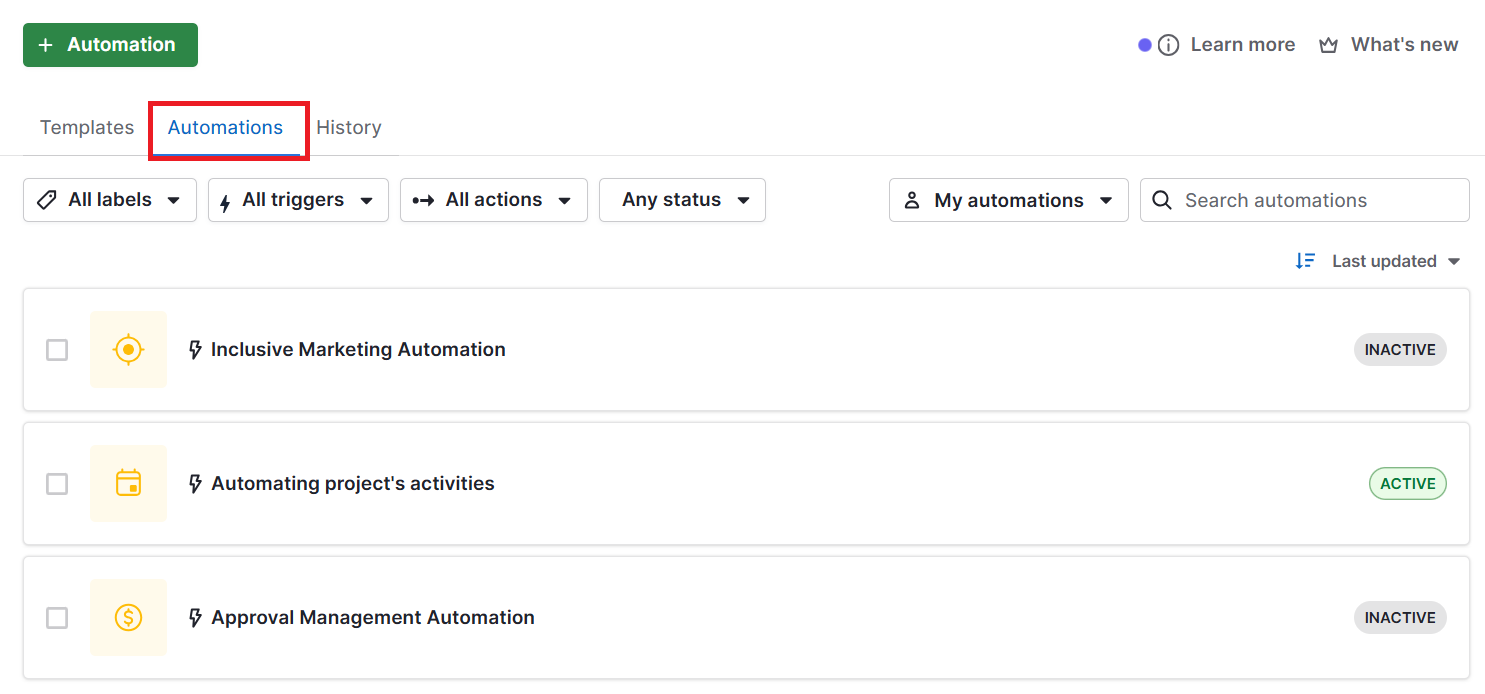
Track campaign success using reports
Reporting and insights show you which inclusive messages land best with different groups.
Create these manually or using natural language prompts like “Which segment had the highest open rates in our recent campaign?” through the AI report generator:
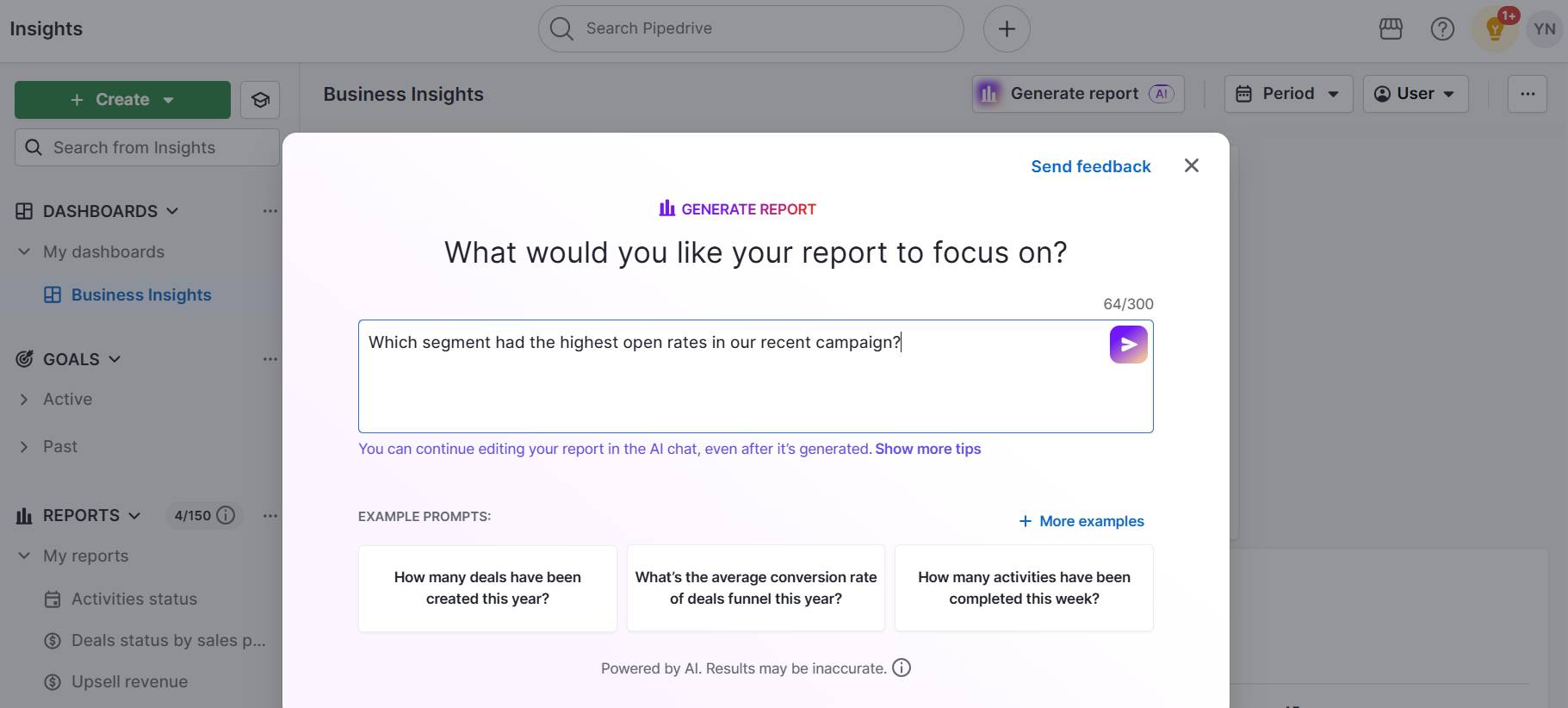
Quickly spot gaps (e.g., specific demographics not engaging as strongly) and adjust campaigns to close them.
Pro tip: Use Pipedrive to log and track accessibility and inclusion key performance indicators (KPIs) like:
- Percentage of campaign images with alt text
- Ratio of inclusive imagery (e.g., showing different ages, races and body types)
- Reading level of email copy (clear and accessible vs. jargon-heavy)
- Percentage of forms and pages that meet ADA basics (e.g., contrast level, screen-reader friendliness)
Over time, your CRM reporting patterns will help you see what’s working and where to improve.
As Pipedrive integrates with your email, social and accessibility-focused platforms, you’ll save time and keep all inclusivity efforts connected.
Use your CRM workflows to reach more people and prove that your business values who they are.
Inclusive marketing FAQs
Final thoughts
Inclusive marketing helps SMBs attract more customers, build stronger loyalty and stand out from competitors who overlook diverse audiences.
At the heart of a successful strategy is a systematic approach supported by the right technology. A robust CRM helps you segment audiences, personalize communication and measure what resonates.
Try Pipedrive free for 14 days to create more effective, trustworthy marketing that translates into tangible sales.






